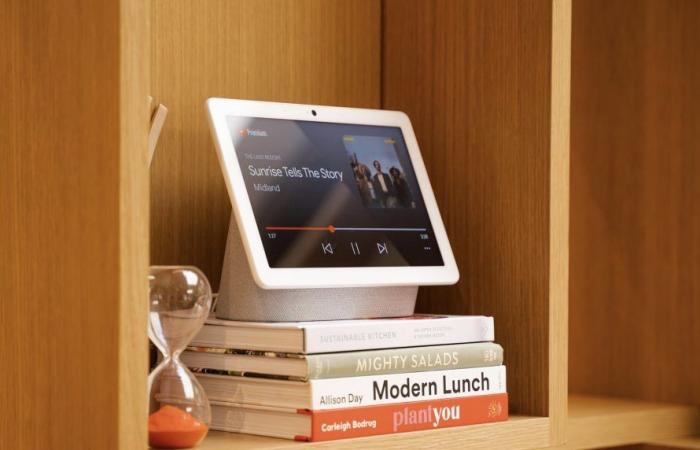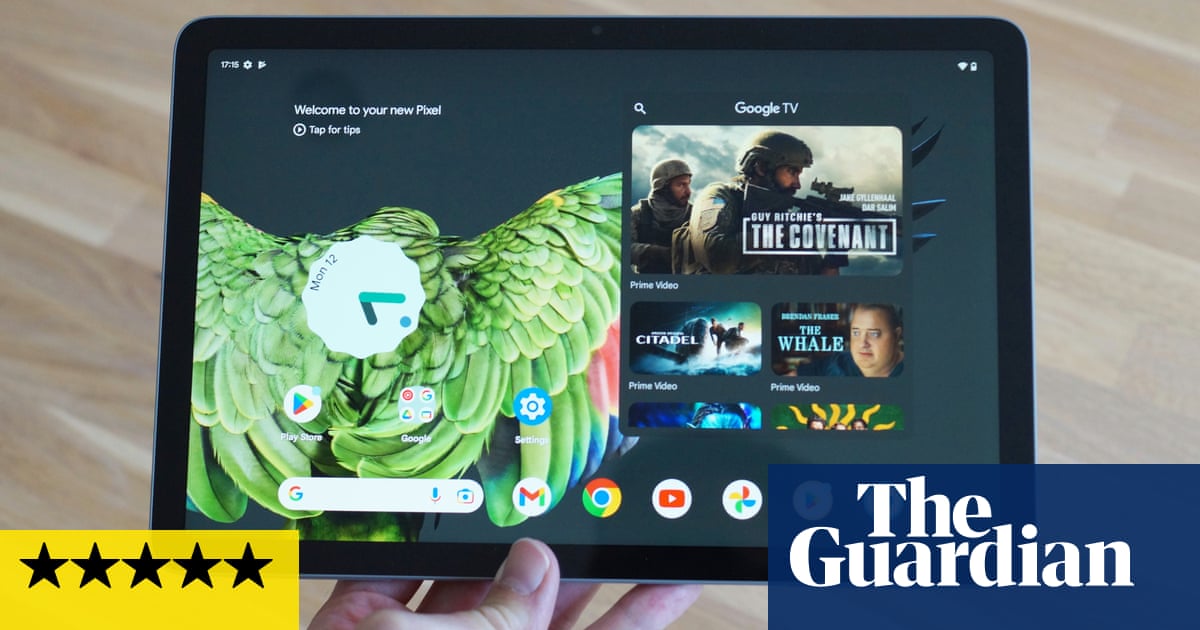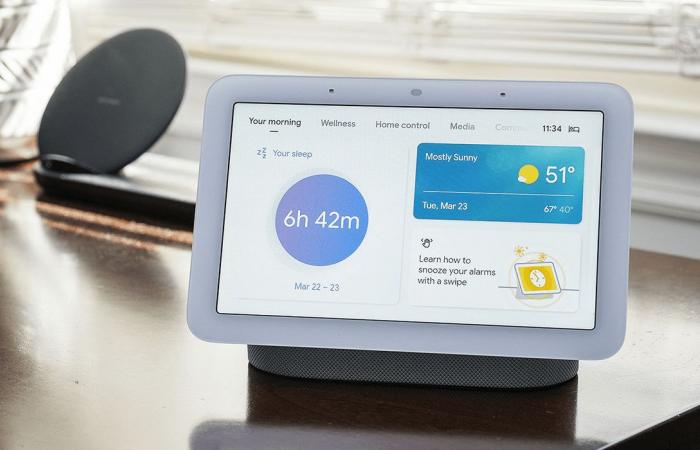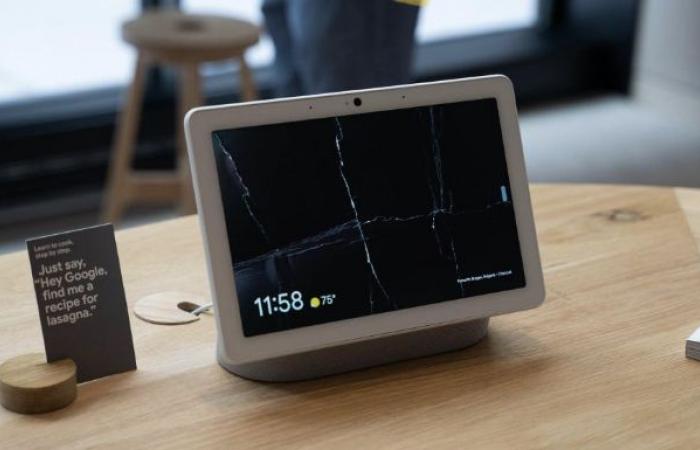
Google’s second-generation Nest Hub smart display now comes with radar-based sleep tracking as it attempts to keep Amazon’s Alexa at bay.
The new Nest Hub costs £89.99 on launch, which makes it cheaper than its predecessor and slightly undercuts competitors of a similar size.
The second-generation unit has the same design as the original but is ever-so-slightly taller. The 7in LCD screen looks great and is crisp enough for viewing at arm’s length or further, making it perfect for use as a digital photo frame. The body is now made of recycled plastic and the screen is covered in an edgeless glass, which makes it easier to wipe clean.
The display is mounted in a fabric foot that contains a louder speaker with 50% more bass than its predecessor. It sounds better than the Nest Mini, but not as powerful as the Nest Audio or similarly sized speakers.
New for the Nest Hub are the ultrasound and Google’s Soli miniature radar sensors, which enable advanced functions without the privacy implications of having a camera. Ultrasound is used to detect when people are near while increasing the size of text when you are further away.
Soli tracks movement for two features. The first is motion sense, which was first introduced on the company’s Pixel 4 phone in 2019 and tracks hand gestures to allow you to pause music, silence alarms and similar. The second is sleep tracking.
Sleep Sense
The Nest Hub uses its radar to track the breathing patterns and sleep of the person lying beside it without the need for a wrist or headband. Put it on a bedside table about an arm’s length away and go to bed as normal.
The device records how long you sleep, restless periods and, optionally, how many times you cough or snore using the microphones. The data is processed locally on the Hub using built-in artificial intelligence, but then synced to Google’s long-standing health service, Fit, so you can see your data on your phone. You cannot opt out of syncing the data with Google Fit, but you can delete it or share it with other services.
The display can also show you a summary of how you slept last night or over the last week. The results were surprisingly good, recording similar length of time slept and disturbances to both wrist-based sleep tracking with a Garmin Fenix 6 Pro Solar and a Withings Sleep Analyzer mat underneath the mattress.
It does not record sleep cycles nor heart rate, which is a key health metric while sleeping, but for a non-contact sleep tracking system that requires no special gear to be worn I was impressed. It can give you tips for better sleep and help you keep a consistent bedtime, suggesting an optimised time after two weeks of tracking.
There is a potential catch, however. Sleep sensing is only in “free preview” until at least the end of the year. The firm says that it is “learning and innovating on this new technology, and also exploring how Sleep Sensing can become a part of the Fitbit and Fitbit Premium experiences” after Google’s recent purchase of the fitness tracker maker. That means Google could start to charge for some or all of the sleep-tracking feature, as it does for the advanced sleep-tracking analysis within its Fitbit Premium subscription.
The Nest Hub can do so-called sunrise alarms. Here the display gradually lights up through warm colours simulating a sunrise for a period immediately before an audible alarm to gently wake you up. It works well if you happen to sleep facing it in a dark room, but will struggle otherwise. The Nest Hub can light up third-party smart lights too for a greater effect.
Plus all the usual smart display features
The Nest Hub can do all of the usual smart assistant things too. It can show you recipes, searches, set timers and alarms, control a large variety of third-party smart home devices and even stream a live feed from compatible smart cameras such as Google’s Nest Hello doorbell.
It plays music and radio including BBC stations, Spotify and via Bluetooth, and can be grouped with other Google speakers for multiroom audio. You can cast video to the display like you would to a TV or Chromecast from most media apps, or play video from Netflix, Disney+ and YouTube directly. The 7in screen is only really big enough for short things or watching TV while doing something else, such as cooking.
It will also play the news, show the weather and personal information such as calendar events, your commute and other things synced with your Google account. Google Assistant can recognise an individual’s voice to give them personalised information such as their calendar or music from their Spotify. You can even do voice calls via Google Duo, but not video calls as it lacks a camera.
Sustainability
The Nest Hub is generally repairable. The casing is made of 54% recycled post-consumer plastic, part of Google’s commitment to include recycled materials in all its products launching from 2022. The company publishes environmental impact reports for some of its products, but has yet to publish one for the updated Nest Hub. Google will recycle devices free of charge.
Observations
It has a Thread radio built in, which will be enabled at a later date for connecting to the next generation of new smart home devices that are in development by various manufacturers.
You can quickly delete your sleep data from the display for up to two hours after waking up and can pause sleep tracking with a quick-settings button.
The interface is generally fast enough, if not exactly snappy, but it can be a bit sluggish to respond when streaming video from a smart camera.
Initial setup of the Nest Hub is done through the Google Home app on Android or iPhone, and takes less than five minutes.
Price
The second-generation Google Nest Hub costs £89.99.
For comparison, the Google Nest Hub Max costs £189, the Lenovo Smart Clock costs £34.99, Amazon Echo Show 5 costs £79.99, the Echo Show 8 costs £99.99 and the Echo Show 10 costs £239.99.
Verdict
The second-generation Google Nest Hub offers quite a few features squeezed into a compact and easy-to-live-with device.
It is very similar to the first generation but the addition of radar for gestures and sleep tracking is useful. It might not record heart rate or your sleep cycle, but provides simple sleep tracking without the faff of having to wear or charge anything. Whether or not you want a Google sleep-tracking device in your bedroom is another matter.
The speaker is better, but not as good as larger smart speakers. Google Assistant is the smartest voice assistant of the bunch and the little 7in display is one of the best digital photo frames you can buy, but it can be a little sluggish here and there.
It is slightly cheaper than similar competitors, and will probably be discounted fairly soon. Meanwhile the first-generation Nest Hub is being flogged at £60 or less.
Pros: sleep tracking without bracelet or headband, good screen, decent speaker, Google Assistant, hand gestures, Cast support for video and music, BBC radio, recycled plastic, no camera for privacy concerns.
Cons: 7in screen a bit small for video, can be a bit slow at times, no camera for video chat.












